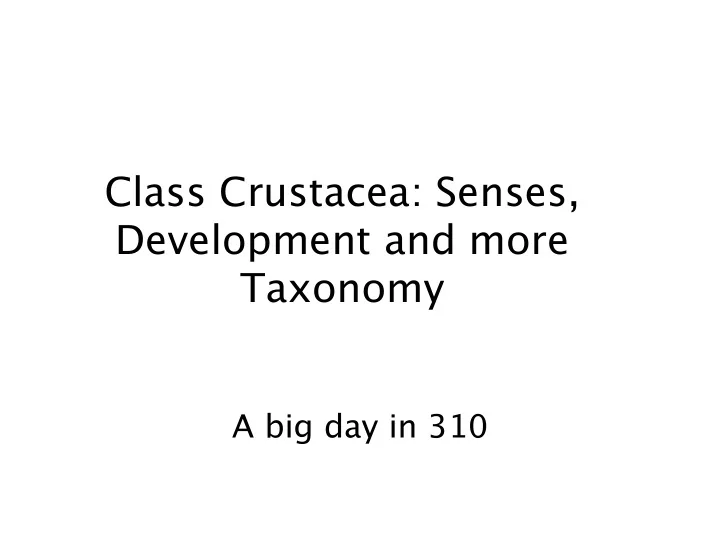

Class Crustacea: Senses, Development and more Taxonomy A big day in 310
Crustacean Senses • Mechanoreception – Touch, “hearing,” proprioception – Proprioception : di fg erent from other senses because it provides internal feedback – i.e. limb position, movement, cuticular stress • Chemoreception • Photoreception
Crustacean Sense Organs • Eyes (photoreception) • Sensory Setae (Mechanoreception and Chemoreception) • Statocysts (balance)
Crustacean Eyes • Most have two compound eyes • Compound eye – Independent photoreception unit containing cornea, lens, and cells to distinguish brightness and color – Ommatidia: single visual unit of compound eye • Naupliar Eye – Does not form images – Determines direction of light source
Types of Compound Eyes • Apposition Eye – Each lens is directly apposed to the rhabdom (photo receptor, light sensing). – Each lens is very small; each rhabdom receives very little light – Works best in bright light • Superposition Eye – Numerous ommatidia combine to direct their light onto a single rhabdom – Animals can see better in dim light
Statocysts • The equilibrium receptor (balance) • Cavity with heavy particle, statolith rests on setae that detect displacement
Setae • Hair like structures used for mechano and chemo reception (and other) • Extend through exoskeleton—linked to the nervous system • Aesthetascs: – Patches of sensory setae usually found on first antennae – Important for locating food and mates
Senses: in lab • We’ll examine chemoreception by counting antennal flicks before and after adding a food smell to the water • We’ll look at setae: both sensory and other • We’ll look at crustacean eyes
Crustacean Development • Very complicated • Number and type of larval stages varies considerably • Crustacean larvae may look nothing like their parents
The Nauplius Larva • Characteristic crustacean larval stage: nauplius • The first crustacean larval form • Many pass through this stage in the egg • Has a head and a telson; the thorax and abdomen have not developed yet • One eye • Starts with three appendages but may add appendages after molting www.mesa.edu Barnacle :www.microscopy-uk.org Copepod :www.theseashore.org
Barnacle Development • Barnacles are highly modified as adults, but the nauplii remain the same • Barnacles spend weeks as a nauplius, undergo 4-6 nauplear molts before molting into a cyprid • Cyprid larva is the final, non-feeding stage before settlement • Cyprid use modified antennae to explore the benthos looking for an appropriate place to settle and metamorphose into an adult www.mesa.edu
Decapod Development • Decapods usually hatch as a prezoea – Not a true larval stage—a compact form still partially enclosed by the egg membrane • Once membrane is shed (few minutes) the larva is called a zoea . • The zoea’s spines expand and harden— making it more di ffj cult for predators to swallow! www.mesa.edu Blue king crab zoea: wikipedia
Decapod Development www.mesa.edu • After weeks or months and several molts as a zoea, decapod larvae molt to the megalops stage • Megalops can both swim and crawl— ideally suited for its sole function of finding good habitat before it settles and becomes a juvenile www.oceanexplorer.noaa.gov
Taxonomy: Subclass Branchiopoda • Many adapted to ephemeral (temporary ponds) or extreme (hypersaline) environments—Maybe because unable to compete or avoid predation in more typical habitat • Many produce cysts that survive long periods of dessication (sea monkeys—add water, hatch instantly) • Characterized by paddle like thoracic appendages that are used for both locomotioin and gas exchange • Composed of 4 orders – Anostroca – Notostraca – Cladocera – Conchostraca
Taxonomy: Subclass Copepoda • Found in fresh, brackish, and marine environments • Found in all marine environments from the surface to depths of over 5000m • Often dominate the marine zooplankton and have incredible ecological importance • May be free living or parasitic. Most free living in one of three orders: – Calanoida – Harpacticoida – Cyclopoida
Taxonomy: Shrimp and Shrimpy Taxa • The term shrimp has been used for any crustacean that doesn’t look like a crab, lobster or barnacle (i.e. brine shrimp) • You will learn to identify true shrimp (Caridea) from all other “shrimp” • You will look at coloration, feeding and behavior in a Crangon —a true shrimp
What we are doing today: • We’re looking at lots of di fg erent organisms, mostly under the scopes • Have fun and ask lots of questions!! • What not to do: – mix fresh and saltwater samples together – mix live and preserved dishes or pipettes
Recommend
More recommend